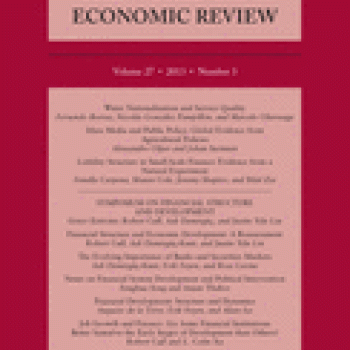Publication Information

Why is the urban-rural gap in child malnutrition increasing in Peru despite government efforts to improve the provision of public services? To answer this question, the impact of regional public expenditure in Peru on young children's nutritional outcomes is examined. To account for policy endogeneity, public expenditures are instrumented using unanticipated regional mining revenues. Even after accounting for changes in expenditure composition due to increases in mining revenues, public spending has a significant and positive impact on children's outcomes only in urban areas. However, even in urban areas, barriers exist that diminish the effectiveness of public expenditure, so indigenous and frailer children in these areas do not benefit from public spending. These children face constraints that limit their ability to use public services. This result reveals the paramount importance of initial conditions. In rural areas, possibly because of the lower quantity and quality of public services, there is no positive effect for any children.
Article written using Young Lives data from the UK Data Archive by researcher from the International Food Policy Research Institute.
ReferenceGissele Gajate-Garrido (2013) 'Excluding the Rural Population: The Impact of Public Expenditure on Child Malnutrition in Peru', World Bank Economic Review 28.3: 525-544
The full version of the article is available on the journal website.

Why is the urban-rural gap in child malnutrition increasing in Peru despite government efforts to improve the provision of public services? To answer this question, the impact of regional public expenditure in Peru on young children's nutritional outcomes is examined. To account for policy endogeneity, public expenditures are instrumented using unanticipated regional mining revenues. Even after accounting for changes in expenditure composition due to increases in mining revenues, public spending has a significant and positive impact on children's outcomes only in urban areas. However, even in urban areas, barriers exist that diminish the effectiveness of public expenditure, so indigenous and frailer children in these areas do not benefit from public spending. These children face constraints that limit their ability to use public services. This result reveals the paramount importance of initial conditions. In rural areas, possibly because of the lower quantity and quality of public services, there is no positive effect for any children.
Article written using Young Lives data from the UK Data Archive by researcher from the International Food Policy Research Institute.
ReferenceGissele Gajate-Garrido (2013) 'Excluding the Rural Population: The Impact of Public Expenditure on Child Malnutrition in Peru', World Bank Economic Review 28.3: 525-544
The full version of the article is available on the journal website.

